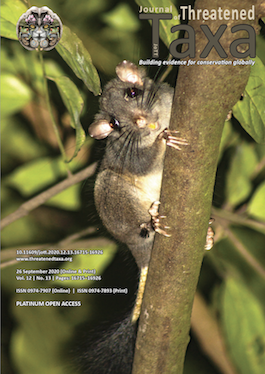Notes on a communal roosting of two oakblues (Lepidoptera: Lycaenidae: Arhopala) and the Common Emigrant (Pieridae: Catopsilia pomona) butterflies in Uttarakhand, India
Main Article Content
Abstract
Communal roosting on an over-nightly basis is common in butterflies for resting and for avoiding predation. Having a source of nectar and safeguarding from harsh weather conditions are also notable parameters to consider a site as a potential roosting spot. Roosting differs from a congregation in the fact that the latter happens mainly in the exposed plant part or the oozing out of fluid, which attracts the butterflies to extract chemicals from the same. The current study has been conducted on an Elephant-apple tree Dillenia indica in the New Forest campus of Dehradun, Uttarakhand, India to observe the roosting behaviour of three blue butterfly species, namely: Large Oakblue Arhopala amantes, Indian Oakblue Arhopala atrax, and pierid butterfly Common Emigrant Catopsilia pomona. The roosting observation was first noted during mid-October. The coinciding of the roosting period and the fruiting season of the tree may mark the importance of having a food source in a potent roosting site. Moreover, the site would provide a shady area with dense foliage, which would also include safeguards against predation.
Article Details
Authors own the copyright to the articles published in JoTT. This is indicated explicitly in each publication. The authors grant permission to the publisher Wildlife Information Liaison Development (WILD) Society to publish the article in the Journal of Threatened Taxa. The authors recognize WILD as the original publisher, and to sell hard copies of the Journal and article to any buyer. JoTT is registered under the Creative Commons Attribution 4.0 International License (CC BY), which allows authors to retain copyright ownership. Under this license the authors allow anyone to download, cite, use the data, modify, reprint, copy and distribute provided the authors and source of publication are credited through appropriate citations (e.g., Son et al. (2016). Bats (Mammalia: Chiroptera) of the southeastern Truong Son Mountains, Quang Ngai Province, Vietnam. Journal of Threatened Taxa 8(7): 8953–8969. https://doi.org/10.11609/jott.2785.8.7.8953-8969). Users of the data do not require specific permission from the authors or the publisher.
References
Antram, C.B. (1924). Butterflies of India. Thacker, Spink & Co., Calcutta and Simla, India, 226pp.
Champion, H.G. & S.K. Seth (1968). A Revised Survey of Forest Types of India. Govt. of India Press, New Delhi, 404pp.
DeVries, P.J., J. Schull & N. Greig (1987). Synchronous nocturnal activity and gregarious roosting in the neotropical skipper butterfly Celaenorrhinus fritzgaertneri (Lepidoptera: Hesperiidae). Zoological Journal of the Linnean Society 89(1): 89–103.
F.R.I. (2019). Nature’s Kaleidoscope-Biodiversity of the New Forest Dehradun. Forest Research Institute, Dehradun, 186pp.
Kehimkar, I.D. (2008). Book of Indian Butterflies. Oxford University Press, Mumbai, 497pp.
Kunte, K. (2000). India, a Lifescape: Butterflies of Peninsular India. Universities Press, Hyderabad, 254pp.
Kunte, K., S. Sondhi & P. Roy (Chief Editors) (2019). Butterflies of India, v. 2.65. Indian Foundation for Butterflies. https://www.ifoundbutterflies.org Electronic version accessed 15 December 2018.
Lewis, S.E. (1995). Roost fidelity of bats: a review. Journal of Mammalogy 76(2): 481–496.
Merkel, F.R. & A. Mosbech (2008). Diurnal and nocturnal feeding strategies in Common Eiders. Waterbirds 31(4): 580–587.
Patil, M.D. (2016). Natural history observations on mass congregation and diapause behaviour of pre-migratory roosting Danainae (Lepidoptera: Nymphalidae) from Sahyadri Mountains, India. South Asian Journal of Life Sciences 4(1): 25–31.
Pearson, D.L. & J.J. Anderson (1985). Perching heights and nocturnal communal roosts of some tiger beetles (Coleoptera: Cicindelidae) in southeastern Peru. Biotropica 17(2): 126–129.
Salcedo, C. (2010). Environmental elements involved in communal roosting in Heliconius butterflies (Lepidoptera: Nymphalidae). Environmental Entomology 39(3): 907–911.
Singh, A.P. (1999). New Forest, Dehradun, India: a unique man-made habitat for butterflies in the lower western Himalayas. Indian Forester 125(9): 913–922
Singh, A.P. (2011). Butterflies of India. Om Books International, Delhi, 184pp.
Smetacek, P. (2002). The study of butterflies. Resonance 7(7): 6–14.
Smetacek, P. (2017). A Naturalist’s Guide to the Butterflies of India, Pakistan, Nepal, Bhutan, Bangladesh and Sri Lanka. John Beaufoy Publishing Limited, London, 176pp.
Soini, P. (1987). Ecology of the saddle-back tamarin Saguinus fuscicollis illigeri on the Rio Pacaya, northeastern Peru. Folia Primatologica 49(1): 11–32.
Sondhi, S., B. Valappil, Y. Sondhi & A. Sondhi (2017). A report on some butterflies (Lepidoptera) from Ladakh in Jammu & Kashmir and Lahaul in Himachal Pradesh, India. Journal of Threatened Taxa 9(3): 9971–9987. https://doi.org/10.11609/jott.3024.9.3.9971-9987 DOI: https://doi.org/10.11609/jott.3024.9.3.9971-9987
Tigers, S., C. Crows & B. Tigers (2014). Danainae congregation in the Konkan region of Maharashtra, India. Current Science 106(4): 514.
Ward, P. (1965). Feeding ecology of the Black‐faced Dioch Quelea quelea in Nigeria. Ibis 107(2): 173–214.
Wynter-Blyth, M.A. (1957). Butterflies of the Indian region. Bombay Natural History Society, Mumbai, 523pp.

